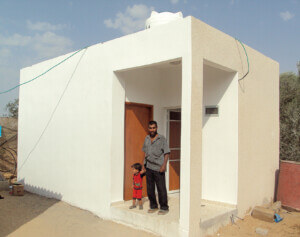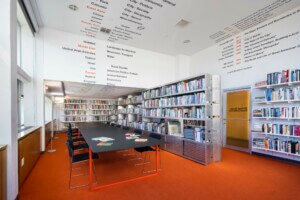In the exhibition Metrophysics, New York-based Michael Sorkin Studio and Terreform (both helmed by Sorkin) have brought their portfolio of eco-futurist-tinged urban designs to Los Angeles’s Southern California Institute of Architecture (SCI-Arc) in Los Angeles, displaying a sprawling retrospective of the symbiotic architectural groups’ collective output from over the years.
The work presented by Sorkin and Terreform—the latter of which is a 501(c)3 established in 2005 as a self-described “ ‘friend of the court’ dedicated to raising urban expectations and advocating for innovative and progressive ideas as widely as possible”—traces a broad stylistic and conceptual arc across time spanning from the mid-1990s through today. That arc hewed closely to the always-shifting focus of other ecologically-minded architectural firms: From dramatic landscape design in the 1990s to embodying technologically-derived formalism in the early 2000s and, more recently, a hybrid between the two.
The exhibition, displayed neatly and semi-chronologically along a series of mounted display boards set atop wooden sawhorses, aims for grandiosity in content if not format. The collected schemes feature board after board of idealized eco-utopias. Some are depicted with Kazimir Malevich-inspired geometric abstraction, verdant, photo-realistic eye wash, or as techno-futurist blobitecture.
According to the firm’s website, the body of work acts as a metaphorical extension of Terreform’s ongoing project, New York City (Steady) State, a “comprehensive investigation into urban self-sufficiency…intended to raise issues and propose solutions for cities around the world that seek to take radical measures to secure their respiration and autonomy and to achieve a more sustainably democratic polity, founded in the local.”
As a result, each project presented uses the underlying notions of New York City (Steady) State to speculate on the potential for ecologically-minded urbanism in other locales. The works attempt to imbue their architecture with a sense of cosmological meaning by fusing the naturalistic geometries spawned by ecological, parametric design with old-school New Urbanism.
New York City is, in fact, featured heavily across the collected projects, with a thoughtful and dramatically rendered vision for a transit hub in the Bronx from 2002 and the firm’s proposal for a temporary enclosure for the rubble at the former World Trade Center site from 2001 providing eloquent and compelling visions that stand somewhat outside some of the exhibition’s more general themes.
Ex nihilo East Asian towns and business districts are also featured prominently in the collection of work, with the Penang Peaks project from 2004 (a horseshoe-shaped cluster of mushroom-shaped towers gathered around a body of water), Skyscrapers with Chinese Characteristics (an exploration that translates Sorkin’s collection of “scholar’s rocks” into tall buildings), and an Ecological Golf Resort for Australia from 2014 best showcasing the firms’ ability to generate a sort of contextually-based, ecologically-driven formalism.
Central to the groups’ experiments are several notions due to be tested in coming years, namely that cities are in fact resilient and nimble democratic systems that can countenance the ever-growing list of maladies they face, including climate change, growing income disparities, and the ever-increasing flow of antiseptic global capital. Sorkin’s team implies with its research that both new and existing cities have the potential to overcome these stresses, but only if thoughtfully and ecologically designed. This will certainly be a challenge as a new era of incompetent authoritarianism takes hold globally.
Terreform’s showcase at SCI-Arc, with its broad stylistic mantle and critical urban approach, has the potential to inject a dose of inspiration for a university in transition and city searching for a new moral compass. The cornucopia of drawing styles alone should provide fertile ground for the current generation of students hungry to cut and paste their way toward new modes of formal expression.
And though the works in question vary greatly in terms of representational techniques, muses, and thought bubbles, Sorkin’s detail-oriented gaze remains consistent, whether it involves the tiny white ribbons representing pigeons drawn onto the firm’s Bronx transit plans or the technicolor landscapes of the Weed, Arizona project.
The question—for after the exhibition closes—is whether SCI-Arc students will be inspired by techno-ecology and what a transition from designing at an urban scale to designing ecologically-driven urbanism might look like moving forward.
—
Metrophysics
SCI-Arc Gallery
960 East 3rd Street
Los Angeles, CA 90013
Through December 4










